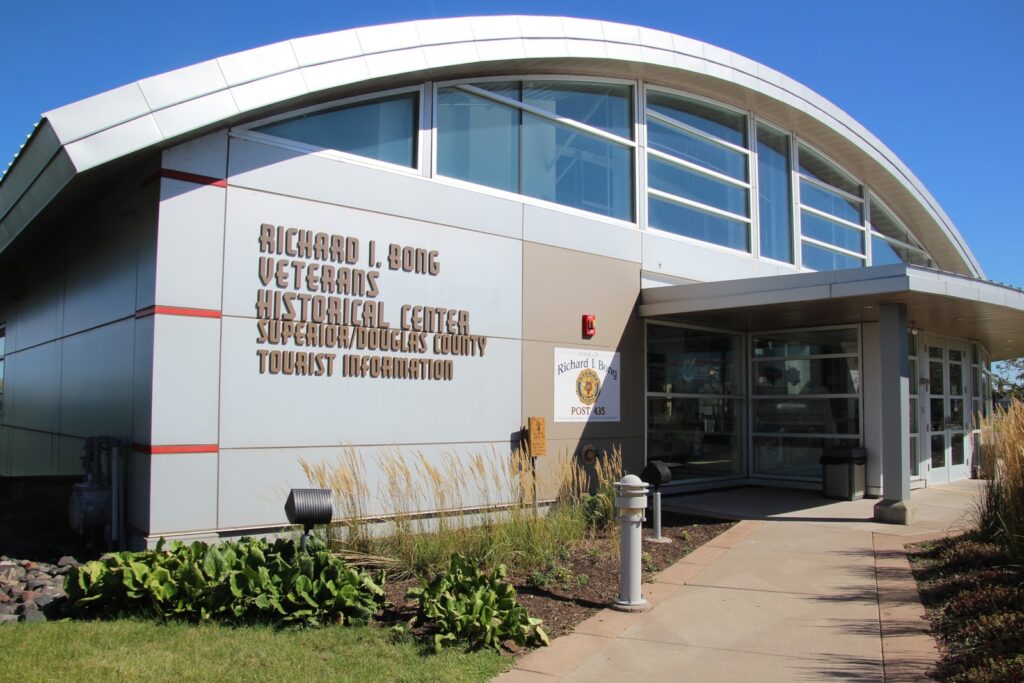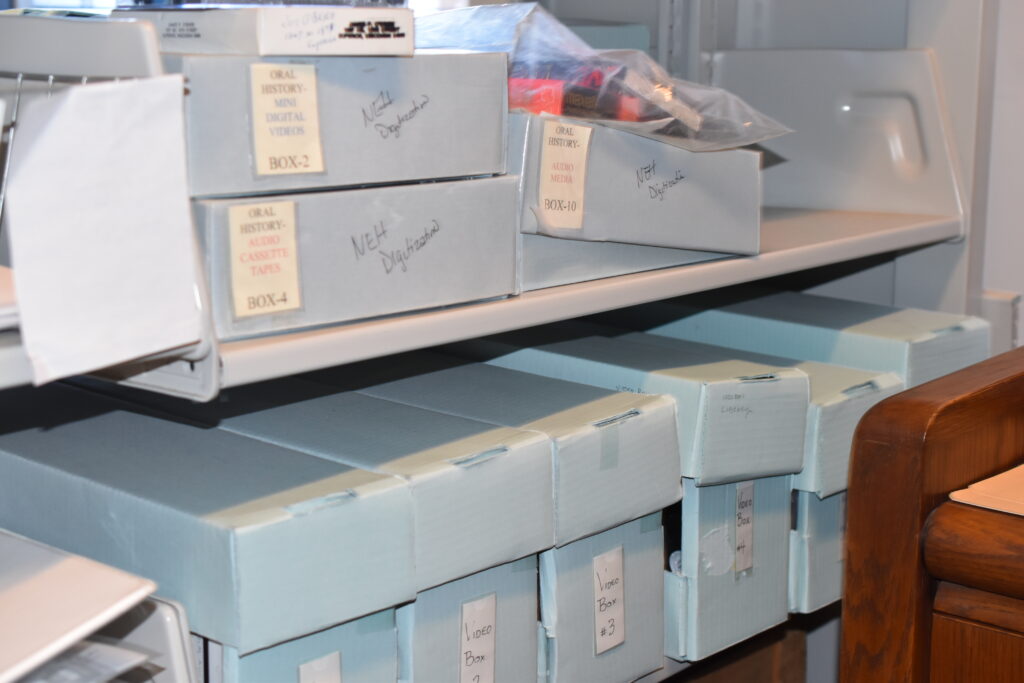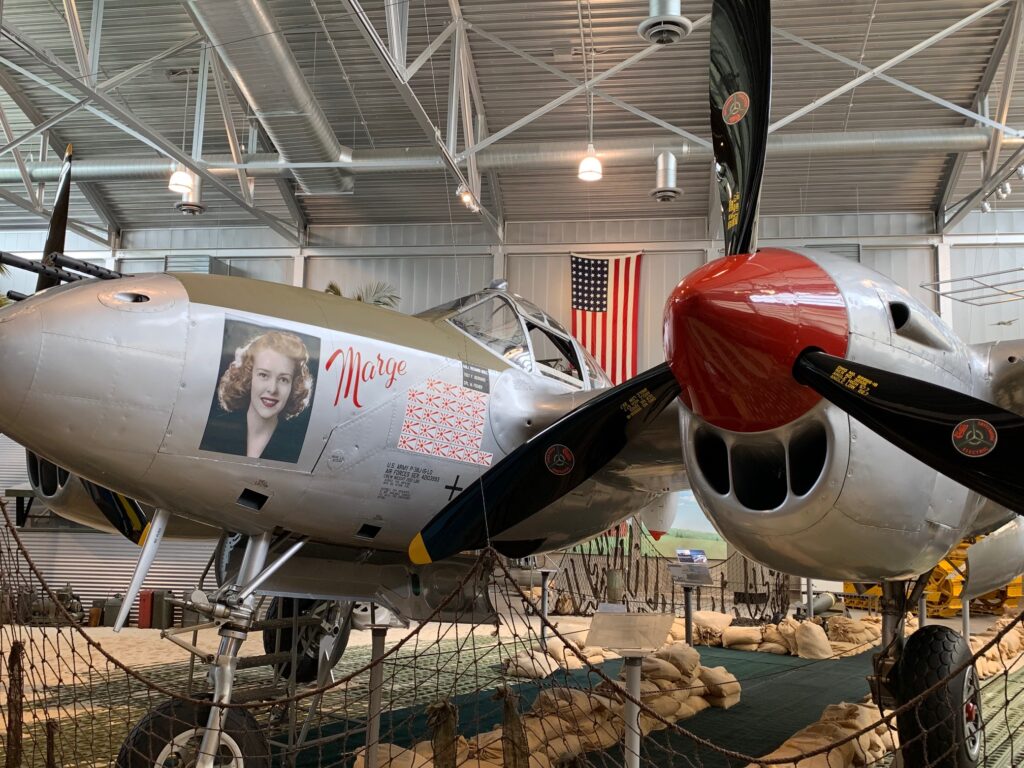Located in Superior, Wisconsin, the Richard I. Bong Veterans Historical Center preserves and honors the memory of Major Richard I. (Dick) Bong and all veterans of World War II and subsequent conflicts, and provides educational resources for the Twin Ports area community and beyond. A native of Poplar, Wisconsin, Major Bong was known as America’s “Ace of Aces” for flying his P-38 Lightning through more than 200 missions over the Southwest Pacific during World War II and destroying 40 enemy planes. Bong survived World War II but, sadly, lost his life testing a jet plane in August 1945.
The Richard I. Bong World War II Historical Center (BVHC) opened to the public on September 24, 2002, on what would have been Dick Bong’s 82nd birthday. The BVHC maintains a remarkable collection of historic records and artifacts that document Wisconsin veterans and their military service including service records, uniforms and insignia, oral history interviews, photographs and scrapbooks, and wartime artifacts including a restored P-38 Lightning!

Briana Fiandt, has been an integral part of the BVHC for many years, serving as the gift shop manager from 2005-2007 while completing her master’s degree in library science. After positions at UW River Falls and Santa Fe, New Mexico Community College, Fiandt returned to Superior and the BVHC in 2014 as the curator of collections. Currently, Fiandt serves on the Recollection Wisconsin Steering Committee and Education Advisory Group. In 2019, she also participated in Recollection Wisconsin’s Curating Community Digital Collections as a host site supervisor.
Digital projects at the BVHC
Over the past decade, BVHC has been actively digitizing items from their collections, typically to fill patron reference requests or use within a museum exhibit. Their staff also works closely with donors who are interested in temporarily loaning their photos or scrapbooks for digitization. These digital files are then included in the BVHC collections while the originals are returned to the donor. A mix of staff, trained volunteers and student interns support digitization work at the BVHC.
In 2019, the BVHC participated in Curating Community Digital Collections as a host site. This project offered an opportunity to assess and improve their digitization efforts. Throughout the summer, a graduate student intern evaluated their existing workflows and created a bevy of new training materials and documentation following digital preservation best practices including processes for storing and backing up digital files.
Prior to our participation in CCDC, digital work was happening but not in a consistent manner. Creating a digital preservation policy was key to setting us on a more sustainable path.
Briana Fiandt
The work completed through CCDC was an important and welcome opportunity to advance their program. BVHC volunteers now follow more detailed workflows for scanning and cataloging their materials in PastPerfect. These workflows are publicly available on the Recollection Wisconsin website as part of the Richard I. Bong Veterans Historical Center Digital Preservation Policy.
Community support and resources for digital work
Like many local history organizations, Fiandt seeks guidance and tools from other Minnesota- and Wisconsin-based organizations involved in digital work. She has been using Recollection Wisconsin’s digital projects resources for many years, long before she participated in any Recollection Wisconsin-related initiatives and recommends Metadata Essentials, part of Recollection Wisconsin’s Digital Projects Toolkit, as a resource for training student interns on scanning and metadata creation.
A new content management system
Recently, the BVHC decided to migrate their digitized content out of PastPerfect and into Collective Access, a free, open-source content management system for cataloging and sharing museum and archival collections. Concerns about ongoing sustainability and support from PastPerfect motivated this change. A group of Minnesota-based local history organizations formed an affiliation of Collective Access users. The BVHC is working with this community of practice for assistance migrating their content and ongoing support. It is a priority for BVHC to share their collection online and broaden their reach.
Oral histories and Listening to War
The BVHC is one of many Wisconsin local history organizations whose wartime oral histories are included Listening to War: Wisconsin’s Wartime Oral Histories, a National Endowment for the Humanities (NEH)-funded project which brings together first-person accounts of veterans and civilians in Wisconsin during World War I, World War II, the Korean War, the Vietnam War, and the Persian Gulf War.
Fiandt helped to identify 128 oral histories contributed by the BVHC. With limited descriptive information, it was challenging to discern which oral histories were Wisconsin veteran’s stories. Most of the BVHC interviews document the WWII-era, both home front and combat experiences, but there are also stories from soldiers who served in Korea, Vietnam, and Iraq. These oral history interviews are a mix of video and audio file formats and, as a collection development strategy, there are pros and cons to creating either. While a video story may be more engaging, the files tend to be larger and require more server space. Some veterans are more comfortable sharing their experiences off camera, so an audio-only option may be preferable.

Fiandt and the BVHC are thrilled that these veterans’ stories now publicly accessible and that they tell local people’s stories.
Without digitizing and sharing these materials online, people would never hear these very personal stories from their own community members and about their own community history.
Briana Fiandt
Fiandt hopes that once more people discover the Listening to War project, they may think about sharing their own veteran’s or wartime story with the BVHC, or their local historical organization. The project provides an opportunity to reach new donors, by demonstrating how the public might interact with their story on Recollection Wisconsin. They are also working closely with Minnesota’s digital library, Minnesota Reflections, to digitize and share Minnesota veteran’s stories held by the BVHC.
Content warning statements
It’s important to prepare patrons for sensitive or harmful topics and language they might encounter by accessing a collection or viewing an exhibit, especially war-related material. The BVHC indexes their oral history interviews so they are better able to anticipate harmful content and will note any language concerns or extreme acts of violence on their indexing form. They include a disclaimer or language on the website or as part of the metadata to prepare users for the content:
This [item] contains language that is offensive and is presented as it exists in the original documents. The materials reflect the context in which they were created but do not represent the views of the Richard I. Bong Veterans Historical Center.
BVHC content statement language
The BVHC worked closely with the Minnesota Historical Society and their Department of Inclusion and Community Engagement to craft the content statement template language. They discussed the importance of directness in the statement and avoiding language that is permissive or dismissive of the language or content in question. Those are two guideposts they used in putting together the basic template.
Tip: For more information about harmful content and crafting content statements, visit Content Statements.
I wish I had focused on making a few small changes early on for example, adopting consistent file names, to make incremental improvements in our workflow. I had an “all or nothing” perspective that wasn’t a realistic goal.
Briana Fiandt
A few lessons learned…
- Perfect is the enemy of the good. In the past, Fiandt was focused on having a complete or “perfect” plan in place to guide their digital work but realized this approach did not serve them well. Her approach these days is slow and steady, and “picking away at digital preservation one task at a time…you don’t have to try to accomplish it all of it at once.” Fiandt suggests focusing on one or two small goals like developing, implementing, and documenting a file-naming scheme or documenting a scanning process as a training tool for digital projects volunteers. Over time, small goals will become part of a larger, more sustainable digital program.
Tip: Take a look at our Folder & File Renaming Worksheet (PDF) to get started crafting and documenting a new scheme for your project. - Legacy projects can be a challenge. After analyzing the steps necessary to “fix” some of their past work, Fiandt decided to live with some less-than-ideal components of their legacy digitization projects and that a much better use of time and resources would be to focus on current and new projects and adopting the guidelines and best practices developed as part of their new digital preservation policy.
- It’s more than just a policy! Information included in a digital preservation policy provides a good jumping off point for conversations about digital work with different stakeholders. Fiandt was pleased to use their digital preservation policy as an advocacy tool. Sharing this work and documentation with the BVHC Board helped their organization’s leadership understand the need for and approve purchasing new scanner and other digitization equipment.
- Volunteers are key! Like many local history organizations, the BVHC relies on dedicated volunteer staff to get work done. It can be a challenge to keep volunteers engaged, especially when the priority may be more mundane but necessary tasks such as cataloging materials or transcribing oral history interviews. It is often more fun to dress the mannequins or build exhibits! Keep in mind that volunteers have varied skills sets and experience and different work styles, and a range of interests related to local history so it is important to have good training materials and a strong support system in place to guide their work.
Tip: Take a look at Working with Volunteers for more ideas to help you plan for, recruit, support, and recognize volunteer staff. - Working with veterans. If you are interviewing a veteran, always have a conversation with your interviewee before ever turning on the recorder. Ask them what aspects of their service they are comfortable sharing (or not), especially combat experience. Never push an uncomfortable topic. It is OK if an interviewee becomes emotional. For many veterans, telling their story can be a long overdue healing experience. Finally, consider having staff or volunteers who are veterans interview veterans. Sometimes it is easier for them to share their stories with another veteran.

What’s next?
Fiandt hopes to engage new audiences through Listening to War and pro-actively collect more stories from WWII and Korean War veterans. She would love to take their show on the road – mobile oral history collecting — and visit other Wisconsin communities to collect stories. Without question, COVID-19 has rendered oral history collection development work a challenge. In the past, Fiandt and her staff would have coordinated interviewing activities at local nursing homes or other care facilities. BVHC does have an oral history in a backpack – a circulating oral history kit – and Fiandt hopes to partner with their local library to promote this resource. And keep an eye out for digitized materials that document Richard I. Bong’s life and military career.
I’m particularly excited to digitize and publicly share the Richard Bong collection. We have quite a few researchers and historians interested in his story – across the country and the world!
Briana Fiandt
Our sincere thanks to Briana Fiandt and the Bong Veterans Historical Center for sharing their experience with our digital readiness community of practice.
Just the highlights? Download the Center’s Digital Readiness Case Study in Brief (PDF).
This work is funded through an Archives Collaboratives Implementation Grant from the National Historical Publications and Records Commission (NHPRC), the granting arm of the National Archives. Visit Digital Readiness Community of Practice for more information.



You must be logged in to post a comment.